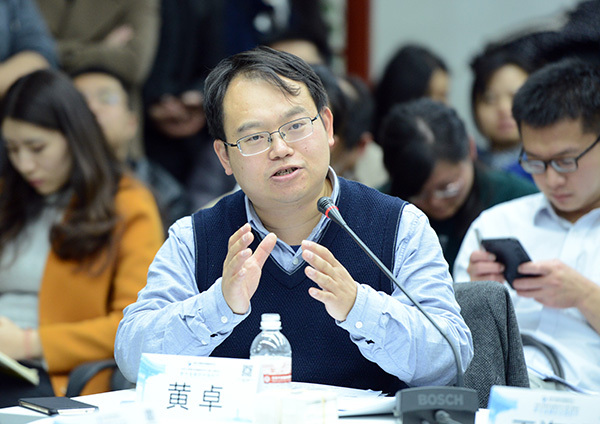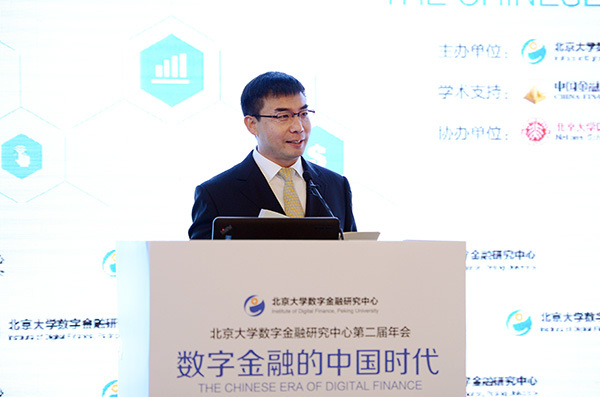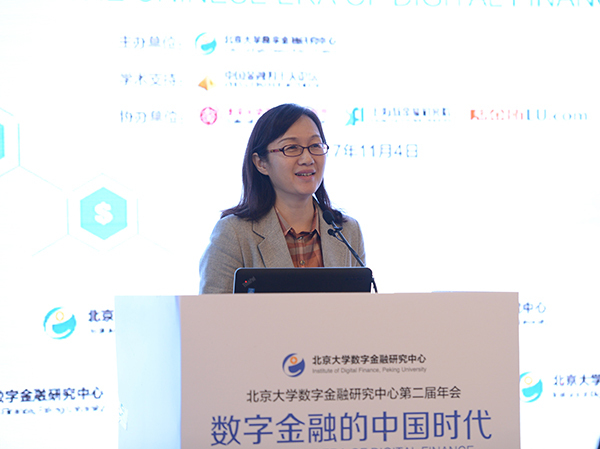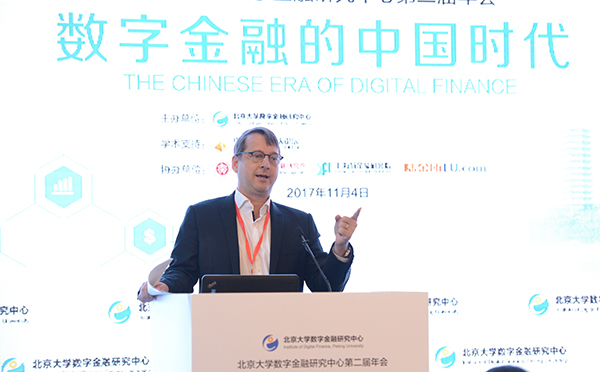IDF’s Second Annual Conference: Three Reports on “China’s Era of Digital Finance”
2017-11-14
Photo: Esteemed guests at the second annual conference
On the evening of the 3rd of November 2017, through to the 4th, Peking university’s Institute of Digital Finance(IDF) successfully held its second annual conference at Langrun Garden, at Peking University’s National School of Development(NSD). The main subject of the meeting was a focus on “China’s Era of Digital Finance”. The meeting was the product of cooperation between Peking University’s National School of Development, the Shanghai Finance Institute (SFI), and Lufax, with academic support also provided by China Finance 40 Forum(CF40).
The rapid development of digital technology has provided new opportunities for China’s financial reform, and some products and technologies developed by Chinese financial science and technology enterprises have already established leading status on a global scale. Banks partaking in traditional commerce have also searched for faster and more effective ways to serve their customers through digital finance. However, digital finance has also brought new risks, and posed new supervisory challenges as well as challenges to the industry as a whole. What experiences in the development of digital finance can China use as guide? What support does digital finance offer to the state of the real economy? How should challenges faced in the process of developing digital finance be dealt with? How can digital finance be effectively supervised? The esteemed guests were invited to discuss these hot topics, and they engaged in a thorough and lively debate.
Responding to these queries, those present – on the evening of the 3rd – first held a seminar on digital finance’s support of the real economy. In this seminar, vice-chairman of the IDF Dr. Zhuo Huang asserted that, from the four perspectives of increasing the procurability of financial services, promoting the transformation and improvement of traditional finance structures and reform of China’s financial system, improving market confidence and raising consumption, and producing new business models and promoting the increased innovation of enterprises, digital finance in China brings a great deal of support and impetus to the development of the real economy.

Photo: Vice-chairman of the IDF, and associate professor of PKU’s National Development Institute, Zhuo Huang.
Prof. Zhuo emphasized that, in terms of promoting innovation, the pursuit of digital finance was certainly worthwhile. He asserted that China is currently in the process of economic transformation and improvement. Taking O2O and shared economies to be representative new economies, Prof. Zhuo explained how they all needed new financial foundations. Digital finance, he argued, can provide an excellent financial foundation for this turning point in the new economy’s expansion.
Photo: Prof. Qiang Li, Chairman of the IDF’s board of directors, and associate professor of PKU’s General Affairs Committee, delivers a speech.

Photo: Executive deputy director of IDF, and secretary of the CF40, Haiming Wang.
Photo: IDF advisor, and former president of the Industrial and Commercial Bank of China, Kaisheng Yang.
Photo: Head of the People’s Bank of China’s Digital Currency Institute Yaoqian Chang.

Photo: Secretary of the China Internet Finance Forum Shuchun Lu.
The main event of the meeting was the full day forum held on the 4th. Prof. Qiang Li, Chairman of the IDF’s board of directors, and associate professor of PKU’s General Affairs Committee, delivered a special speech in a meeting chaired by executive deputy director of IDF, and secretary of the CF40, Haiming Wang. Kaisheng Yang, IDF advisor, and former president of the Industrial and Commercial Bank of China, Shuchun Lu, Secretary of the China Internet Finance Forum, Chenlong Guan, executive of the IDF, and chief strategist of Ant Financial Services Group, Gregory Gibb, CEO and co-chairman of Lufax’s board of directors, Ning Tang, founder and CEO of CreditEase, and many other esteemed guests spoke on the meeting’s main topics. There were exchanges and debate on the meeting’s three main reports, providing fresh, colourful, and varied insight. On the afternoon of the 4th, ten representatives from supervisory institutions, academic spheres, traditional finance institutions and financial science and technology enterprises engaged in a debate on such topics as management, banks’ embrace of financial science and technology, and supervision digital finance in the “era of intelligence”.
Photo: Executive member of the IDF, and chief strategist of Ant Financial Services Group, Chenlong

Photo: Executive member of the IDF, CEO and co-chairman of Lufax’s board of directors, Gregory Gibb.
Photo: Ning Tang, founder and CEO of CreditEase (an executive member of the IDF).
The three reports discussed in the meeting were as follows: The IDF’s Yearly Research Report: Digital Finance’s Support of the Real Economy, The Main IDF Report: Improving Rural Financial Services through Reform and Innovation, and Joint Report between the IDF and SFI: a 2017 Study on the United States’ Fintech.
The IDF’s Yearly Research Report: Digital Finance’s Support of the Real Economy asserted that the development of China’s digital finance is currently at a key directional juncture. At this turning point for the real economy, and propelled by innovations in macro-economic fields, digital financial should resolutely serve the direction of the real economy, as a vanguard of innovation and China’s financial industry’s rise to prominence. In response to the question ‘how does promoting digital finance support the development of the real economy’, the report presented seven policy suggestions. These were as follows:
Firstly, the reform and opening of the financial market needs to continue, and related reforms in other fields must also be accelerated. The ratio of direct investment needs to be increased, and the digitalization of traditional finance institutions encouraged.
Secondly, efforts must continue to perfect the foundational bottleneck of digital finance, and the publication of data from public departments encouraged. A unified, reliable, digital nationwide platform should be constructed, and standards and criterion drafted for access to reliable data and online intercommunications.
Third, scientific research and technological innovations in digital finance should be supported to the upmost degree, strengthening the cultivation of digital finance talents.
Fourth, managerial transparency should be implemented; clear access given to finance science and technology enterprises’ financial operations thresholds and licensing demands; and permission granted to those digital finance enterprises that meet with the given conditions to apply for banking licenses.
Fifth, the safety of digital finance business, data safety, and protection of personal privacy, investors, and borrowers’ rights and interests all need to be improved. Related laws and management regulations also need to be perfected.
Sixth, digital finance should be used to improve the capabilities of financial supervision, and to strike a balance between innovation and risk.
Seventh, and lastly, digital finance should be included in currency policies and the macro-prudential financial supervision framework.
The Main IDF Report: Improving Rural Financial Services through Reform and Innovation bases itself on survey and study of the current financial circumstances in China’s rural areas, and analyses such issues as why effective, competitive financial markets have not yet formed in rural areas, and why rural finance is still just as seriously inhibited as before. The report asserts that, after urbanization, deep reaching development, and large-scale exodus of rural labor to the cities, China’s rural areas and agriculture is now undergoing reconstruction. Taking an end to relocation and analysis of big data to show the rapid development of internet technologies, the report provides technological solutions for the large-scale reduction of the cost of financial services, establishes a basis for a completely new means of financial servicing, and makes some new inclusive finance models more plausible. Amongst these, some have already proven to be useful methods, whilst others still have issues that have not been fully resolved.
Xingqing Ye, Head of the China State Council’s Development Research Centre’s Department of Rural Economy Research, believes that anything that enables traditional finance institutions to use digital finance technology to increase inclusivity and service efficiency is worthy of study. Additionally, two issues need to be resolved: firstly, the issue of over demand, and rural areas’ need for loans. The other is the need to clarify boundaries of rural finances’ market and governance. Mr. Zhang said “In the next step, when there is contradiction between government adjustments, market logic, and societal logic, I think that governments should place an emphasis on the lowering of costs and the removal of risks.”
Photo: Xingqing Ye, Head of the China State Council’s Development Research Centre’s Department of Rural Economy Research, offers his own comments.
As well as those reports discussed above, the meeting also witnessed the presentation of a collaborative report between IDF and SFI: A 2017 Study on the United States’ Fintech. The report introduces the current state of development of the United States’ Fintech, and explains what weight this development carries for China’s internet finance supervision. The report asserts that the core of supervisory policies lies in striking a balance between innovation and stability. It also testifies to the rapid development of the internet finance industry, and the fact that it has not brought huge financial or societal risks; making a genuine contribution to the development of the real economy. The report raises eight suggestions for the supervision of China’s internet finance, including – amongst others – access thresholds for internet finance institutions, increasing “transparency” and implementing “investor suitability” supervisions, and support of stable financial innovations.
Photo: Prof. Yiping Huang, director of the IDF, and vice-chairman of PKU’s Institute of National Development, presents Joint Report between the IDF and SFI: A 2017 Study on the United States’ Fintech
Photo: Guofeng Sun, Head of the People’s Bank of China’s Financial Research Institute, offers his commentary.
During the meeting, the IDF also released its newest collection of data: Peking University’s Financial Science and Technology Sentiment Data. This data was the result of seventeen million characters worth of news articles, drawing support from the handling of natural language, the study of machinated functions, and other methods, producing data on internet finance sentiment from January 2013 all the way to September 2017. The data included both finance science and technology as a whole as well as topics such as P2P internet loans and online payments. This was then calculated on a scale, with an intensity rating from 1-12 to accurately capture the degree to which any given topic captured the public’s attention, and said attention’s positive or negativity. This data shows that, overall, attention payed to financial science and technology to have obeyed a trend of fluctuation, showing particularly extreme undulations in the intensity of positive and negative emotions. Furthermore, the individual categories of financial science and technology show large discrepancies between the degree of attention afforded to them and the fervency of positive or negative emotions.